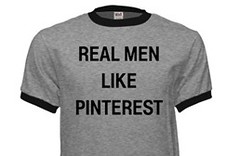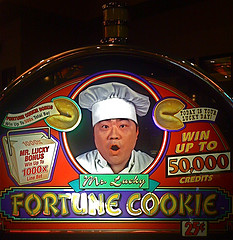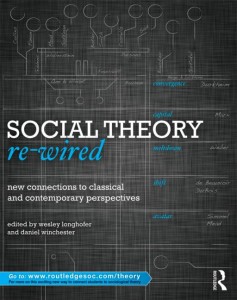Check out this post  on our sister blog about constructing a lesson plan on Pinterest and feminism.
on our sister blog about constructing a lesson plan on Pinterest and feminism.
Check out this post  on our sister blog about constructing a lesson plan on Pinterest and feminism.
on our sister blog about constructing a lesson plan on Pinterest and feminism.
The folks over at Sociological Images, have collected some great examples of the commodification of Black History by companies to market products like kool-aid, hair relaxers, BET, fried chicken and collard greens.

We suggest using these types of ads as a teaching tool in your classroom. First guide the students through the pictures posted on Sociological Images during class. Then, at home, have them find another example of a company using racial stereotypes to sell products (an ad, commercial or something like the image here) and write up a short summary of what stereotypes they believe it portrays. They could email them to you or post links to the class website. This activity would work best after students are familiar with the concept, but early enough in the course that it can inform their thinking for the rest. Sharing these images in class will start a great discussion, as well as get students to pay more attention to this type of racism in the media.
If students are having a hard time finding images, you could direct them to blogs that often post on this topic. For example…Sociological Images, The Color Line, Racialicious, Feministing…and many more!
TSP’s Sarah Lageson recently sat down with Megan Comfort to talk about her research on women in relationships with incarcerated men. You can read a summary of the fascinating interview here and listen to the entire interview here.
This interview would be particularly useful to demonstrate the effects of prisons beyond the incarcerated individual. Below are a few discussion questions that can be used with the interview.
1. Briefly explain “presence creation” in your own words and provide an example.
2. What were some of the key things that women in Comfort’s study valued about their relationships with incarcerated men? Did any surprise you? Why or why not?
3. Can you think of any examples of secondary prisonalization that you’ve seen first-hand or heard about through friends or family?
Earlier this week, a guest on NPR noted that Abraham Lincoln took second (to Jesus) in the number of books written about a modern historical figure. Wow!! It’s clear that he is one of the most remembered U.S. Presidents.
The TSP Reading List suggestion for Presidents’ Day, “History, Commemoration, and Belief: Abraham Lincoln in American Memory, 1945-2001,” explores how Abraham Lincoln is remembered in the U.S. This would be a great article to assign during a unit on collective memory. Before the students read the article, have them each quickly write about how/why they remember Abraham Lincoln. Afterward, survey the class to see if they remember him as the Great Emancipator (the primary memory found in the article), the Savior of the Union, the Man of the People, the Self-Made Man, or the First Frontier American. This article would go well with Gary Alan Fine’s “Reputational Entrepreneurs and the Memory of Incompetence: Melting Supporters, Partisan Warriors, and Images of President Harding.”
The Society Pages’ first White Paper, published earlier this month, focuses on the intersections of politics and sport. White Papers are in-depth explorations of relevant topics in the social sciences and will be an ongoing part of The Society Pages. We recommend using this White Paper, “Politics and Sports: Strange, Secret Bedfellows” by Kyle Green and Doug Hartmann, in your classroom as a great overview of the politics of sports…and the sport of politics. 
This easy-to-read and informative paper explores many topics relevant to your students. Here are a few:
 Looking for a new book to update your social theory course or one to simply jumpstart your first time teaching it? Former Contexts Graduate Editors Wesley Longhofer and Daniel Winchester have created a new book, Social Theory Re-Wired: New Connections to Classical and Contemporary Perspectives (Routledge), which offers a new and exciting way to teach social theory to today’s students. Full disclosure here: due to their work on TSP, we’re not exactly unbiased. We’re proud!
Looking for a new book to update your social theory course or one to simply jumpstart your first time teaching it? Former Contexts Graduate Editors Wesley Longhofer and Daniel Winchester have created a new book, Social Theory Re-Wired: New Connections to Classical and Contemporary Perspectives (Routledge), which offers a new and exciting way to teach social theory to today’s students. Full disclosure here: due to their work on TSP, we’re not exactly unbiased. We’re proud!
The book combines a print reader with an impressive website that provides a wide variety of innovative material including interactive annotations of key readings, summaries of key concepts, biographies of theorists and schools, writing activities with interactive capabilities, and an array of supplemental texts and videos. The reader itself is organized around five vignettes, which range from the financial crisis to our Facebook profiles, and includes original excerpts from Durkheim, Weber, Marx, and Simmel, as well as Judith Butler, Patricia Hill Collins, Pierre Bourdieu, Zygmunt Bauman, and many more. The combination of a print reader with a truly interactive website make this book a useful contribution to any social theory class, whether it is online, in person, or somewhere in between. You can order an exam copy of the book here and peruse portions of the website here.
Wes is currently an assistant professor in the business school at Emory University. Dan is finishing his PhD in sociology at the University of Minnesota.

As sociologist Jessie Daniels notes in a new TSP Special Feature, showing a film in class isn’t just a day off. Instead, films are visual texts, and Jessie suggests many documentaries that could be used in the classroom. Several readers commented, so we thought we would compile all of them into a single post.
Intro Soc Class:
“49 Up” (2005)
“The Split Horn: Life of a Hmong Shaman in America” (2001)
“Quiet Rage” (1991)
“The Devil’s Playground” (2002)
“We Live in Public” (2009)
Globalization/Neoliberalism:
“The End of Poverty?” (2008)
“Garbage Dreams” (2009)
Gender:
“HIP-HOP:Beyond Beats & Rhymes” (2006)
“Southern Comfort” (2001)
“The Pill” (1999)
“Chisolm ‘72: Unbought & Unbossed” (2004)
“Heart of the Game” (2005)
Education:
“Resolved” (2007)
“The Lottery” (2010)
Prison Documentaries for Crime and Punishment Courses
Sweethearts of the Prison Rodeo (2009)
The Dhamma Brothers (2008)
The Farm (1998)
Writ Writer (2008)
Ghosts of Attica (2001)
Re-entry Documentary
Omar and Pete (prison reentry) (2005)
Death & Dying
“Ikiru” (1952)
“The Seventh Seal” (1957)
“Of Gods and Men” (2010)
“Tell Me a Riddle” (1980)
“Dead Man” (1995)
Food/Labor
Harvest of Shame (1960)
American Harvest (2008)
The Harvest/La Cosecha (2011)
New Harvest, Old Shame (1990)
Various Others from TSP Readers:
From Nathan Palmer:
Race The Power of an Illusion Pvert 3: The House We Live In (2003) My favorite film to show how historic and institutional racial discrimination is affecting us to this day. It does a great job connecting whiteness to citizenship and explaining red lining/block busting. I use it in my 101s and race & ethnicity classes.
The Color of Fear (1994) An oldie, but a goodie. The film is a recording of 9 men of different racial ethnic backgrounds talking candidly about race. My only critique of the film is there are no women included and multiple racial groups are left out as well.
Food Inc. (2008) More than anything I want my students in my environmental sociology class to understand how social inequality and environmental degradation are connected. The portion of this film dedicated to the mistreatment of farmers, factory workers, and the animals/land they use is priceless.
The Battle for Whiteclay (2008) This independent film documents how 4 liquor stores in Whiteclay, NE (a town of 14 people) sell 12,500 cans of beer a day. The off-sale liquor stores take advantage of their proximity to the Pine Ridge Reservation, who banned alcohol sales and possession on their lands. Despite there being no legal place for the 12,500 cans to be consumed (Whiteclay only has off-sale establishments) there have been nearly no arrests while the liquor dealers make millions of dollars annually. The video is an excellent example of government corruption, exploitation, and selective law enforcement.
Inside Job (2010) The 2008 credit crisis is a perfect example of how changes at the institutional level have a cascading affect all the way down to the individual. It also gets at how social problems are socially constructed. This film more than any other explains the complex crisis in a way that is approachable.
From Andrew Lindner:
“Manufactured Landscapes” (2006), based on the work of photographer Edward Burtynsky, it has some unbelievable footage from Chinese factories. Great for teaching about globalization and capitalism.
“Paradise Lost: The Child Murders at Robin Hood Hills” (1996) – a classic documentary on the (now recently freed) West Memphis Three. A powerful and disturbing illustration of stigma and social control.
“The War Room” (1993) – an insider’s look into Bill Clinton’s path to victory in the 1992 primaries. I use this in my “Political Sociology” course to talk about rhetoric, political strategy, and political professionals.
“Flow: For Love of Water” (2008) – a terrifying documentary on our dwindling water supply and how it is owned and managed by corporations for profit. Great for discussions of capitalism, privatization, or environmental sociology.
“Secret of the Wild Child” (1994) – an outstanding PBS/Nova documentary on feral children, particularly the famous Genie case mentioned in almost every sociology text. Challenges many students assumptions about socialization.
Clip Ideas from Carolyn Liebler:
Little Miss Sunshine – for students to pick out examples of material culture, non-material culture, subculture, counterculture, face and face work, front stage, and back stage behavior.
Wedding Crashers – as a way to apply the following theories of deviance: rational choice, labeling theory, differential association theory, and obligatory action.
The beginning of Ghostbusters – to apply the three major tenets of ethical research methods
Fiddler on the Roof – to play “spot that social institution!” and talk about how social institutions are interrelated.
From Joe Soss:
The Society Pages’ second Roundtable, Laughter and the Political Landscape, asked media and communication scholars to reflect on political humor and satire. The Roundtable would be a great resource in any class or section on media and politics. I may be outing myself here as a complete addict of The Daily Show, but how can you not use The Daily Show for a section on political humor?!
The Daily Show and The Colbert Report are very lefty (even though Stephen Colbert’s bit is as a staunch conservative), but wherever your students are politically, these shows serve as a great example of using satire in a surface way (focusing on a politician’s physical characteristics, for example), as well as a tool to criticize their character and politics.
The Roundtable poses the question of how political humor works to engage young people in politics. You could use the Roundtable discussion to get a conversation going in your class about how students understand and digest political humor as well as their perceptions of its potential for encouraging political engagement.
One of our sister blogs recently posted on the issue of welcoming new students. The blog author was emailed by an elementary teacher who is expecting a new student from China. The student will be the only Asian child in the community, and the teacher was seeking advice on how to help him feel less alone or isolated. We enjoyed reading the blog’s response, found here, and wanted to share it!
The first of many roundtables on TSP explores how social scientists study social movements. It would be a great complement to a discussion on social movements or a discussion of research methodology. And, to give you more ideas on teaching social movements, Professor Ron Aminzade was kind enough to provide us with a syllabus he has used in the past. The syllabus is from 2004, so adding this roundtable and some other new literature would be a good step. Download it here!